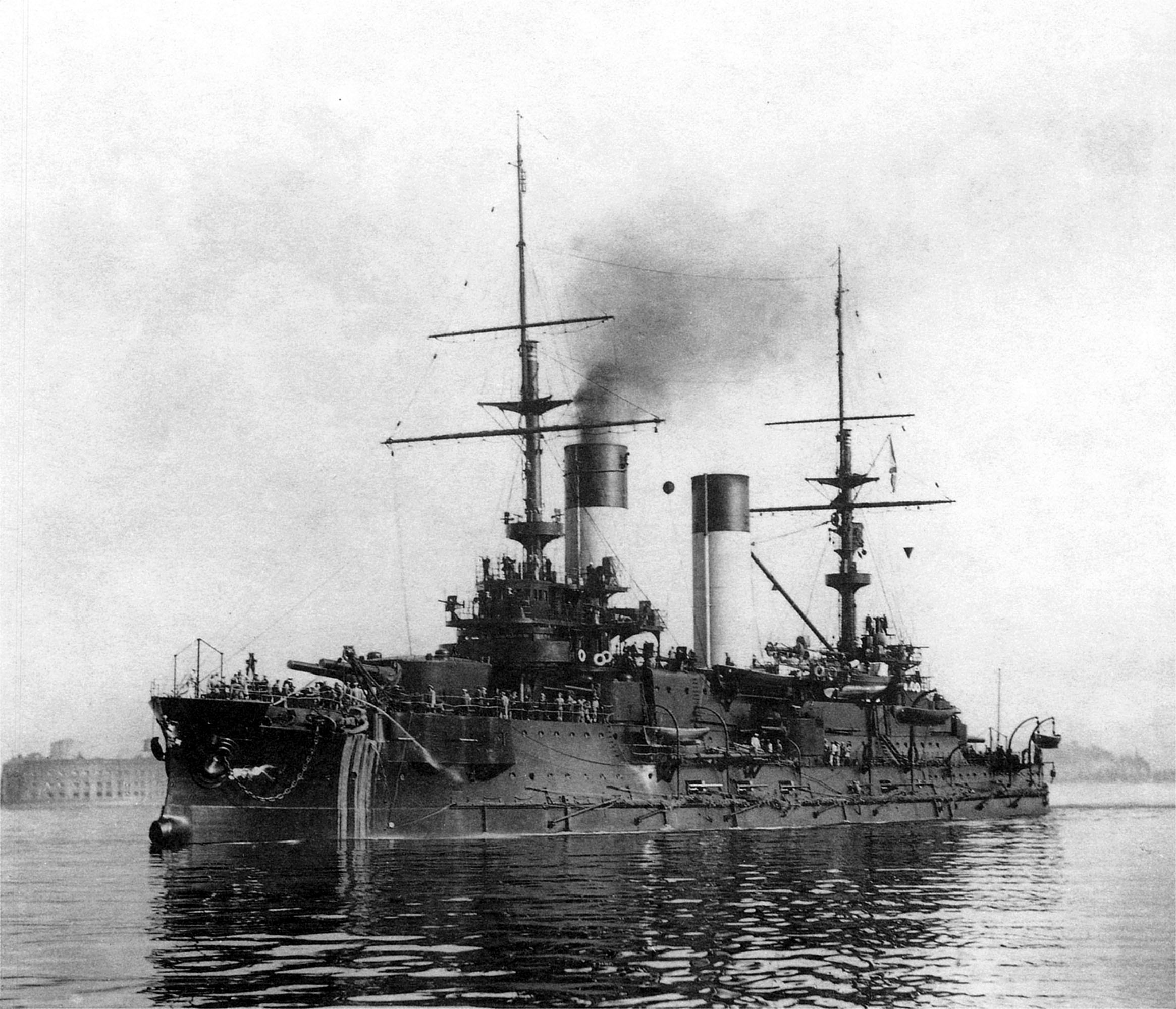Kronstadt 1904. Original url
Russian Varyag becoming Japanese Soya
Russian Peresvet and Pobeda becoming Japanese Sagami and Suwo
An item reported that the Japanese navy was rearming the former Russian ships Orel (1), Warvaj (2), Pereswiet (3) en Pobjeda (4)in Japanese service renamed Iwami, Soya, Sagami and Suwo. The 6x2-15cm guns of the Iwami were replaced by 6-20,3cm guns, of the Sagami and Suwo were the 4-25,4cm guns replaced by 30,5cm L/45 guns with the 15cm guns in the bow removed just like the fighting tops in the masts. Further more was just on a small scale converted of many of the damaged Russian guns just repaired in stead of replaced.
Notes
1. Pre dreadnought battleship Oryol of the Borodino-class, building ordered on 7 November 1899, laid down at the Galerniy Island Shipyards, St. Petersburg, Russia on 1 June 1900, launched on 19 July 1902, completed in October 1904, captured by Japan on 28 May 1905, stricken from Russian naval list on 13 September 1905, commissioned as the Iwami in Japanese navy in April 1907 and finally sink while used as a targt on 10 July 1924.
2.. The protected cruiser Varyag laid down at William Cramp and Sons, Philadelphia in October 1898, launched on 31 October 1899, commissioned in the Russian navy on 2 January 1901, scuttled on 9 February 1904, in Japanese navy commissioned as the Soya on 9 July 1907, returned to Russia on 5 April 1916 and retained her original name, run aground in 1920 and broken up in 1925.
3. Of the Russian pre-dreadnought battleships Peresvet-class. Laid down at the Baltic Yard, St. Petersburg, Russia on 21 November 1895, launched on 18 May 1898, building costs 10.540.000 rubles, commissioned in August 1901, scuttled by her own crew on 7 December 1904 and captured by Japan in January 1905 after Port Arthur fell in Japanese hands. After she was refloated on 29 June 1905 was she renamed as a 1st class coastal defence ship Sagami and commissioned on 20 July 1908 and sold back to Russia in March 1916. After her arrival at Vladivostok on 3 April 1916 was she again named Peresvet. Commissioned as an armoured cruiser. On a distance of around 10 nautical miles north of Port Said were two mines hit laid by the German submarine SM U-73. Heavily damaged broke a fire out and she sunk. Displacement of 13.810 long tons/14.032 tons and as dimensions 132,4 x 21,8 c 8,0 metres or 434.5 x 71.6 x 26.3 feet. The 3 vertical triple expansion engines and 30 Belleville boilers delivered via 3 shafts 14.500 ihp allowing a speed of 18 knots and with a speed of 10 knots a range of 6.200 nautical miles. Her crew in Russian service numbered 769 men, in Japanese 791 men. The armament consisted of 2x2-254,cm/10” guns, 11x1-15,2cm/6” quick firing guns, 20x1-7,5cm/3 quick firing guns, 20x1-4,7cm/1.9” guns, 8x1-3,7cm/1,5” guns, 5x-38,1cm/15” torpedo tubes ( surfaced, 2 submerged) and she could take 45 mines with her for anchorage protection. The Harvey made armour consisted of a 10,2-22,9cm/4-9” thick belt, a 5,1-7,6cm/2-3” thick deck with the gun turrets protected by 22,9cm,/9”.
4. Of the Russian pre-dreadnought battleships Peresvet-class. Laid down at Baltic Works, St. Petersburg, Russian on 21 February 1899, launched on 10 May 1900, building costs 10.050.000 rubles, commissioned in October 1902, sunk on 7 December 1904 off Port Arthur, after Port Arthur fell in January 1905 in Japanese waters, refloated on 17 October 1905 and commissioned in the Japanese navy as 1st class battleship and renamed Suwo on 25 October 1905, reconstructed between May 1905 and 10 October 1908 at the Yokosuka Naval Yard and of which part of her armament was removed, reclassified as coastal defence ship on 28 August 1912, used as training ship for cadets and engineers, active service in 1914, gunnery training ship since 1916, armour removed and disarmed at the Kure Naval Arsenal in April 1922 as a result of the Washington Naval Treaty and capsized on 13 July 1922. Her final faith is somehow uncertain, some sources claimed she was broken up between 1922 and 1923, but is also claimed that she was not earlier broken up at Kure as in 1946. Displacement of 13.810 long tons/14.032 tons and as dimensions 132,4 x 21,8 c 8,0 metres or 434.5 x 71.6 x 26.3 feet. The 3 vertical triple expansion engines and 30 Belleville boilers delivered via 3 shafts 14.500 ihp allowing a speed of 18 knots and with a speed of 10 knots a range of 6.200 nautical miles. Her crew in Russian service numbered 769 men. The armament consisted of 2x2-254,cm/10” guns, 11x1-15,2cm/6” quick firing guns, 20x1-7,5cm/3 quick firing guns, 20x1-4,7cm/1.9” guns, 8x1-3,7cm/1,5” guns, 5x-38,1cm/15” torpedo tubes *3 surfaced, 2 submerged) and she could take 45 mines with her for anchorage protection. The Harvey made armour consisted of a 10,2-22,9cm/4-9” thick belt, a 5,1-7,6cm/2-3” thick deck with the gun turrets protected by 22,9cm/9” armour.

